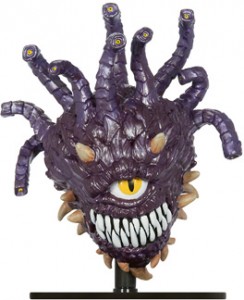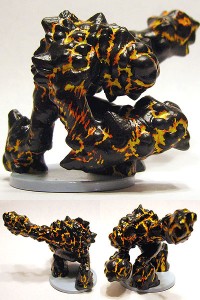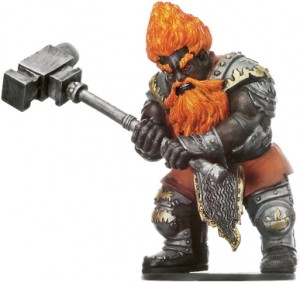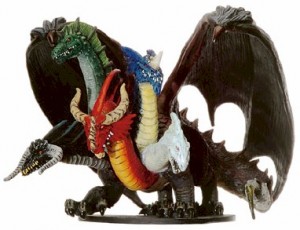On Friday we comb through our extensive archives to find an older article that we feel deserves another look. From July 20, 2011, Dungeon’s Master once again presents: Eenie, Meennie, Mini.
 I wasn’t a fan of minis until 4e came along. The introduction of very tactical combat made the conversion easy. I enjoy the different perspective that a large mini represents on the battlefield, how lines of sight might be affected and how the battle in general unfolds. Of course it has also led to several members of the Dungeon’s Master team to develop rather large collections of minis. Which is all to my benefit as a player and DM.
I wasn’t a fan of minis until 4e came along. The introduction of very tactical combat made the conversion easy. I enjoy the different perspective that a large mini represents on the battlefield, how lines of sight might be affected and how the battle in general unfolds. Of course it has also led to several members of the Dungeon’s Master team to develop rather large collections of minis. Which is all to my benefit as a player and DM.
One of the questions I’m constantly debating is whether to use a mini that matches the monster they player’s are fighting. Now let me clear up that last statement. If the players are fighting a dragon, a beholder or a giant I use the appropriate mini. The dragon might not be the right colour, thought that’s usually not a problem, but the mini at least represents the monster.
Where I’m less specific is with humanoid combatants. My half-orc’s might look like humans, and my minotaurs might look like elves. As long as I have a mini on the table I’m usually satisfied.
Where this philosophy runs into trouble is when the players aren’t paying attention or when I do a poor job at describing the scene. The question I often ask myself is should I use different mini’s in different fights when they represent different monsters. In a recent combat I was using a humanoid with a sword who had a power that slid the players. In the very next combat I used the same mini, only this time it represented a minion. This was a distinct and purposeful choice. I wanted to test the assumptions of my players and see how closely they were paying attention. What I wonder is whether it is a fair tactic to employ against my players or not?
 There are ultimately three factors that need to be considered when you are selecting your mini’s. The level of description you as the DM are providing, how closely your players are paying attention and playing with player assumptions. How these three factors play out will determine the level of fairness that appears evident. Of course if you have the correct mini for a particular monster, you’ll likely want to use it and not something else.
There are ultimately three factors that need to be considered when you are selecting your mini’s. The level of description you as the DM are providing, how closely your players are paying attention and playing with player assumptions. How these three factors play out will determine the level of fairness that appears evident. Of course if you have the correct mini for a particular monster, you’ll likely want to use it and not something else.
Describing Your Mini’s
Certain mini’s don’t require a great deal of guesswork by the players to determine what they are fighting. When you drop a dragon on the table they know what’s at stake. Furthermore the size of the dragon allows them to guess at the difficulty.
As the DM you have a principal duty to describe the scene to your players. You are the only one who can tell them what they see, hear, smell, taste and touch. You are literally the embodiement of their senses. If you don’t describe it, it didn’t happen. So when you are using a generic mini of a human knight, except it should be a half-orc with an axe but you don’t have that mini, you need to provide that information to the players. Otherwise they assume they are fighting a human knight and will make assumptions based on that visual knowledge.
In other words if you don’t describe it right, you as the DM will be cheating not only your players, but yourself. After all you designed the encounter. To not describe it accurately is unfair and detracts from the gaming experience of everyone involved. The depth of your description is up to you. Some are content with stating that the mini is an orc, wielding an axe, dressed in hide armour. Some may describe the same mini as a bloodthirsty orc savage from the Mror Holds, he brandishes an axe with a notch on the shaft for every foe he has beheaded, his ragged hide armour is sewn together from various animal skins. Same monster, different description. Which you use is up to you, it’s just important that you provide one.
Pay Attention Players!
 I don’t recall the last time every player at my table was paying attention to me or the battle all at the same time. Some were busy researching the power they wanted to use and was there a particular way to exploit it versus this opponent. Others were chatting amongst themselves, still others were surfing the internet. I can’t make my players pay attention 100% of the time. One player tunes in on his turn, quickly picks a power, rolls to hit, moves if necessary and then ends his turn. He promptly tunes out again. It’s annoying that he tunes out, but I will give him credit for the speed in which he completes his turn.
I don’t recall the last time every player at my table was paying attention to me or the battle all at the same time. Some were busy researching the power they wanted to use and was there a particular way to exploit it versus this opponent. Others were chatting amongst themselves, still others were surfing the internet. I can’t make my players pay attention 100% of the time. One player tunes in on his turn, quickly picks a power, rolls to hit, moves if necessary and then ends his turn. He promptly tunes out again. It’s annoying that he tunes out, but I will give him credit for the speed in which he completes his turn.
I don’t believe as the DM it’s my job to babysit my players. As a result I’m not going to ring a bell or put my hand up for silence so that I can describe the scene. The game that is transpiring should be reasonably apparent to everyone and as a result I describe the action and monsters when appropriate. If a player isn’t paying attention, well I just consider that a roll of 1 on his Perception check. This isn’t to say I won’t re-describe the monster or situation when asked. Though it’s annoying to repeat myself, it’s also unfair to tell the player no.
My request of players is simple – pay attention! It sounds easy, but it doesn’t always work. That’s ok, because you can use your players lack of focus or attention against them.

Playing With Assumptions
You know the old expression – never assume it makes an ass out of you and me. Well players like to assume and they are creatures of habit. If you know one or several of your players aren’t paying the attention when they should, reuse a mini. Make sure to describe it and differentiate it from the previous encounter as normal. Your players that are paying attention will reap the benefit. Those that aren’t will make an incorrect assumption.
Of course those not paying attention will eventually realize their error of their ways. However, this might not happen before they make a key tactical error or use a daily power when an at-will should have sufficed. It might not seem fair, but you did describe the scene before hand. You can’t control whether your player took the information in or not.
How do you select the minis that you use in your game? Do you always try to use an accurate mini to depict the scene? Do you insist on buying new minis or are you content to use and reuse minis from your existing collection?
Related reading:
Follow @ameron_dm
[jetpack_subscription_form title=”Looking for Instant Updates?” subscribe_text=”Subscribe to the Dungeon’s Master Feed for up to date info from your favourite D&D site.” subscribe_button=”Sign Up Now”]
4 replies on “Friday Favourite: Eenie, Meennie, Mini – Using Minis that Match the Monster”
I usually paint up miniatures that closely match the characters that my players use. When I don’t have those, I will print out markers (see below).
For the monsters, I usually find pictures that best represent the monster I’m using. I will print them out on card stock and make little markers or pawns on the game board.
This website describes the method:
http://rpghacker.com/rpg-hobby-games/diy-pathfinder-beginner-box-style-pawns/
I enjoy having a collection of minis. I enjoy painting them (when I can find the time), and I like having the ability to accurately portray the scene. I do tend to favor the minis I use for characters, since they are going to be used most often and most consistently for said character, so for a longstanding campaign I like the mini to be as accurate to the character as possible.
When it comes to monsters, having a horde of orcs attacking the PCs is difficult to show accurately when you dont have a horde of orc minis at your disposal, so using other humanoids is always something to expect. I try to make sure instead that any distinctly different foe is denoted with a distinctly different mini.
As my collection is still small, I lack in a lot of variety, so we find various other tokens when we need to. One friend brought a pack of player pieces for the Munchkin board game as generic minis, and we have several other common items we use primarily as stand-ins. However, I must say that having a completely accurate group of minis for a situation is a good feeling.
I have a large collection of minis. The minis actually attracted me to D&D. If I don’t have the mini, or a reasonable representation, I don’t use the monster in an encounter. I also like finding a kewl mini that isn’t in a MM, and creating the stats for it. This takes a lot of minis, but it is more fun for the players and me.
With 5e, you have a lot more of low level monsters in a fight. Even higher level monsters will generally have more than 1 in a fight as the party’s level goes up. This means a lot of minis. Since I am running an AP, I generally know what is coming up. So I try to get 1 of each kind of mini I might need. The rest of the minis in an encounter are filler if I don’t have minis that match. But I will point out that they all look like this one.